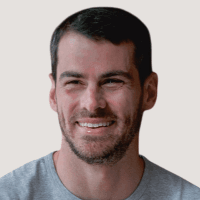

How Flodesk designs for quality in the age of AI
Yuri leads the product design team at Flodesk. In this piece, he shares how stepping into a new role changed how he thinks about quality, how the team is using AI to prototype smarter, and why taste still sets great products apart, especially when everyone can build something fast.
Main Takeaways
- Scaling design means codifying what used to be intuitive.
- Everyone can build now, taste is what sets you apart.
- AI speeds up the how, but you still need to care about the why.
I joined Flodesk as a principal designer, working side by side with Rebecca, our CDO and one of the founders. We were just two people on the product design team, figuring things out together. I designed across the product. Feedback loops were tight. We made fast calls.
Now we’re six designers, the company has tripled in size, and my role looks very different. I still pair with designers, but most of my time is about enabling others, making sure the team is set up to succeed, and that we’re all designing with the same core mindset.
From individual decisions to shared principles
When it was just two of us, we didn’t need to write anything down. We talked, we iterated, we shipped. But with a bigger team, we realized how much lived only in our heads. What does “good” mean here? What’s the right level of craft? What trade-offs are okay?
We started writing things down. We talked as a team about what we value, how we design, and what principles we want to guide us. Not just design principles, but product principles. Something everyone could use: PMs, engineers, support, marketing.
Because otherwise, we’d all design and build in different directions. And we started seeing that: people solving the same problem in very different ways, because we hadn’t taken time to get aligned on the problem in the first place.
So now we spend more time in discovery. Talking to our members. Looking at real feedback. Doing competitive research. Getting clear, not just on the problem, but on how we, as Flodesk, want to solve it in our very own way.
Quality means more than polish
I used to think quality was in the details like the spacing, the rhythm, the animations. And it definitely is. But I’ve also come to see it’s in much more than that: how fast something loads, how clearly it’s written, how well it performs overall.
Design doesn’t ship a product on its own. You need engineers who care about how things feel. PMs who care about clarity. Copywriters who care about tone. Customer Support who keep the service quality high. When quality is shared, it shows.
How we’re using AI
We started experimenting with tools like Lovable, v0, and Figma Make. Every Monday, the design team meets for an hour. We each bring a small prototype and explain how we built it, just to learn together. What worked? What didn’t? What did you try?
If it’s a multi-screen flow, we still use Figma’s native prototyping. But for a focused interaction, something small, specific, high-fidelity, these tools are great. Faster than Figma. More real. Easier to test.
We’re still early, but it’s helping. The whole point is to reduce the gap between idea and something you can actually look at and react to. These tools do that.
Everyone prototypes now, and that’s good
PMs share Lovable prototypes with us. Founders too. Some are rough, some are surprisingly good. It’s never about ego.
If someone shares a better version of what I was trying to do, great. We learn from each other. The product gets better. That’s what matters.
There’s less “imagine this” and more “look at this.” That clarity helps. It also raises the bar, not just for design, but for how we work as a team, between product, design, and engineering.
What still makes the difference? Taste.
Taste is how you show what you care about. It’s how you make decisions when the tools don’t tell you what to do. It’s what makes your product feel like yours — not like something the internet built.
That line from Jony Ive at a podcast with one of the Stripe founders from a few weeks ago stuck with me. And I think it’s more true now than ever.
AI isn’t something to be afraid of. Whether you’re scared or excited, it’s coming. So you might as well be curious.
Keep learning. Try things. Don’t let fear freeze you. But most importantly stay true to yourself and develop your personal taste. Curate and collect things you like.
We still need people who care. Who think in systems. Who pay attention to the little things. Who see the bigger picture. That hasn’t changed. It’s just gotten faster.
And that’s exciting.
Perspectives: Honest conversations on crafting great products over a cup of coffee.
I sit down with friends across design, data, engineering, ops, and more—people who work closely with product leaders, from PMs to CPOs. We talk about how teams really work, where things break down, and how AI and new ways of working are reshaping the future of product.
Coffee of the day
Playground Coffee Roasters · Single Origin Coffee Huila · Hamburg
